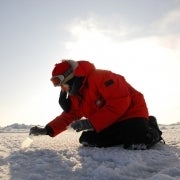Solving a mercury mystery at 40 below
Written by Beth Bohnert, as published in the spring 2010 edition of the Waterloo Magazine

An atmospheric mercury specialist with Environment Canada, Steffen (MSc ’96; BSc ’93) is contributing to the research that supports the agreement. For the past 12 years, she’s conducted fieldwork in the High Arctic that demonstrates the impact of this potentially poisonous heavy metal.
Airborne mercury can travel through the atmosphere thousands of miles from its source, and usually takes one or two years to dissipate from the air. Except in the Arctic.
In 1995, Steffen was one of the researchers who discovered that when the polar sunrise starts to melt sea ice, a chemical reaction occurs, causing mercury to dissipate far more quickly. In a matter of hours, rather than months or years, the metal coats snow and ice surfaces, potentially leaching into the ocean.
From here, mercury may enter the food web, and accumulate in fish and the people and wildlife that eat them. Long-term exposure to mercury damages the brain, kidneys, lungs and nervous system, especially in young animals and children.
Since the initial discovery, Steffen and other Canadian scientists have been studying exactly how the combination of sun and sea salts manages to de-stabilize mercury so rapidly.
It’s not easy work.
After all, how many of us are warned on our first day on the job never to confront a polar bear? The 24-hour daylight from March to September wreaks havoc on sleeping patterns. And of course, there’s the cold. Sandy and her teammates often spend hours on the ice, taking samples and monitoring data collection. At -40⁰ F, the expression “My computer’s frozen” takes on a whole new meaning; Steffen has been known to tuck her laptop in her down-filled pants to keep it functioning.
But despite the challenges, Steffens loves the Arctic, with its beauty, freshness and sweeping landscapes.
Because it’s a very big place with very few inhabitants, you tend to meet people year after year. And because you have to work so closely, the relationships you develop become extremely important, she says.
Especially with the co-worker who’s got your back in case of bears.